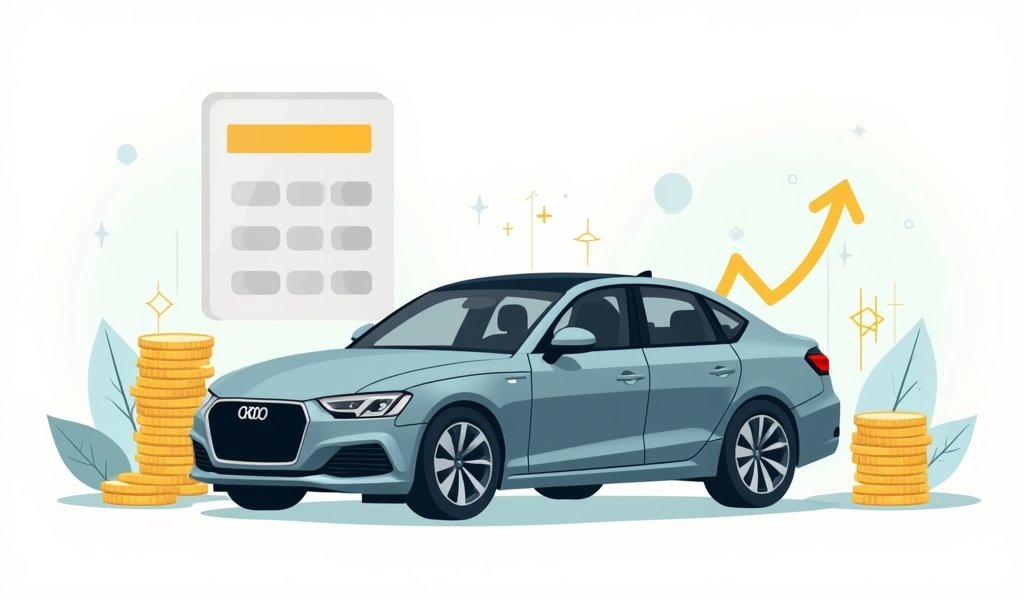Overview
This article provides four key strategies to save money on car loans: optimizing down payments, choosing the right loan term, refinancing when advantageous, and making extra payments toward principal. It emphasizes understanding the true cost of financing beyond monthly payments and using loan calculators to make informed decisions that could save thousands of dollars over a loan’s lifetime.
Table of Contents
- Understanding Car Loans: The Road to Financial Clarity
- The Hidden Costs That Can Drive Your Finances Off a Cliff
- How a Car Loan Calculator Becomes Your Financial GPS
- Interest-Saving Hack #1: The Down Payment Sweet Spot
- Interest-Saving Hack #2: Mastering Loan Term Strategy
- Interest-Saving Hack #3: Refinancing Your Way to Savings
- Interest-Saving Hack #4: The Extra Payment Turbocharger
- Financial Potholes: Common Car Loan Mistakes to Avoid
- Conclusion: Driving Toward Financial Freedom
- Frequently Asked Questions
The open road might promise freedom, but car payments can feel like financial handcuffs. With today’s rollercoaster interest rates, understanding what you’re really paying for that shiny new ride has never been more important. Trust me, I’ve seen plenty of folks who thought they scored a deal at the dealership only to realize they’ll be paying thousands more than necessary over the life of their loan.
But here’s the good news: armed with the right knowledge and a few clever strategies, you can save a small fortune on your car financing. I’m about to share some interest-saving hacks that dealerships hope you never discover. These aren’t complicated financial maneuvers – they’re practical approaches that any car buyer can use to keep more money in their pocket.
Understanding Car Loans: The Road to Financial Clarity
Before we pop the hood on savings strategies, let’s make sure we understand what makes car loans tick. Think of your auto loan as having three main parts: the principal (the amount you’re borrowing), the interest (what you’re paying for the privilege of using someone else’s money), and the term (how long you’ll be making payments).
When lenders mention APR (Annual Percentage Rate), they’re talking about the yearly cost of borrowing, including both interest and fees. Your down payment reduces the amount you need to finance, while your loan term – typically ranging from 36 to 84 months – determines how long you’ll be making those monthly payments.
Several factors affect your interest rate, making each borrower’s situation unique:
- Credit score (higher scores can save you thousands)
- Loan term (shorter terms usually mean better rates)
- New vs. used vehicle (new cars typically come with lower rates)
- Current economic environment
- Your debt-to-income ratio
- Existing relationship with the lender
Your credit score has the most significant impact on your rate. According to Experian’s research, the difference between excellent and poor credit could mean paying an additional 10% interest – that’s thousands of dollars over the life of your loan.
The Hidden Costs That Can Drive Your Finances Off a Cliff
That sticker price you see on the windshield? It’s just the beginning. The real cost includes interest payments that can add thousands to your bottom line. For example, on a $30,000 loan with a 6% interest rate over 5 years, you’ll pay nearly $5,000 in interest alone – enough for several years of maintenance or a pretty sweet vacation.
Here’s something most dealers won’t tell you: many make more profit from their financing department than from selling the actual vehicles. They often receive kickbacks from lenders for securing loans, and some even mark up the interest rate above what you qualified for, pocketing the difference as pure profit.
The most dangerous trap in car buying is what I call the “monthly payment mindset.” When you focus solely on whether you can afford $400 a month instead of the total cost, you’re essentially giving dealers permission to extend your term, jack up your interest rate, or add unnecessary products – all while keeping that monthly payment right where you’re comfortable. This is how a $25,000 car turns into a $35,000 expense.

How a Car Loan Calculator Becomes Your Financial GPS
Knowledge is horsepower when it comes to auto financing, and a good car loan calculator is your engine for financial clarity. Think of it as the diagnostic tool that helps you see what’s really happening with your money before you sign on the dotted line.
To use a car loan calculator effectively, you’ll need:
- The vehicle price you’re considering
- Your planned down payment amount
- Your estimated credit score range
- The loan term you’re considering
- Any trade-in value (if applicable)
Once you input these numbers, a good calculator will show you not just the monthly payment but also the total interest paid over the loan’s life, the total cost of ownership, and how different scenarios might affect your bottom line. This gives you powerful leverage in negotiations because you’ll know exactly how much that “dealer special financing” is really costing you.
Most importantly, using a calculator before shopping helps you set realistic expectations about what you can afford based on the total cost – not just the monthly payment that dealers love to focus on.
Interest-Saving Hack #1: The Down Payment Sweet Spot
Your down payment is your first opportunity to gain leverage against interest charges – think of it as a head start in a race against compound interest. But contrary to what you might have heard, there’s no one-size-fits-all percentage that works for everyone.
Let’s look at a real example for a $35,000 vehicle with a 60-month term at 5% interest:
- $0 down: Total interest paid = $4,600
- $3,500 (10%) down: Total interest paid = $4,140 (savings: $460)
- $7,000 (20%) down: Total interest paid = $3,680 (savings: $920)
- $10,500 (30%) down: Total interest paid = $3,220 (savings: $1,380)
While putting more down always saves interest, the sweet spot depends on what financial mechanics call your “opportunity cost.” If you have investments earning more than your loan’s interest rate, it might make more sense to make a smaller down payment and keep your money working elsewhere. However, if you’re carrying high-interest debt, using available cash for a larger down payment could be the smarter move.
One often-overlooked strategy is making a down payment just large enough to avoid requiring private mortgage insurance (PMI) or to qualify for a better interest rate tier. Sometimes an additional $500-1,000 down can unlock a 0.5% better interest rate, saving you far more than that additional down payment over the loan’s life.
Interest-Saving Hack #2: Mastering Loan Term Strategy
When it comes to loan terms, shorter isn’t automatically better for everyone – it’s about finding the right balance for your financial situation. While a 36-month loan will almost always cost less in total interest than a 72-month loan, the higher monthly payments might strain your budget unnecessarily.
One powerful yet simple hack is the biweekly payment strategy. Instead of making one monthly payment, you make half-payments every two weeks. This results in 26 half-payments per year, which equals 13 full monthly payments instead of 12. That extra payment goes straight to your principal, reducing both your loan term and total interest.
For example, on a $25,000 loan with a 6% interest rate and a 60-month term:
- Standard monthly payment plan: $483/month, total interest = $4,000
- Biweekly payment plan: $241.50 every two weeks, total interest = $3,600
The beauty of this approach is that it aligns with how most people get paid (biweekly), making it easier to budget while quietly saving you hundreds without feeling the pinch of higher payments.
Finding your personal break-even point – where the benefits of a shorter term outweigh the higher monthly payments – depends on your cash flow, other financial obligations, and long-term goals. The right car financing calculator can help you pinpoint this sweet spot with precision.

Interest-Saving Hack #3: Refinancing Your Way to Savings
Refinancing your car loan is like changing lanes to avoid traffic – sometimes it’s the smartest move you can make. Consider refinancing when:
- Your credit score has improved significantly since getting your original loan
- Market interest rates have dropped since you took out your loan
- Your financial situation has changed and you need different terms
- You’re unhappy with your current lender’s service
To determine if refinancing makes financial sense, compare the potential savings against any refinancing costs. As a rule of thumb, look for an interest rate reduction of at least 1-2 percentage points to make the process worthwhile.
The refinancing process is simpler than changing your car’s oil:
- Check your current loan details (payoff amount, remaining term, interest rate)
- Shop around for better rates with banks, credit unions, and online lenders
- Calculate your potential savings using our calculator
- Apply with the best lender
- Complete the paperwork (usually less than what was required for your original loan)
- Start saving with your new, improved loan
Here’s a real-world example: Sarah refinanced her $20,000 car loan with 48 months remaining, dropping her interest rate from 7.5% to 4.5%. This simple move saved her over $1,300 in interest and reduced her monthly payment by $28 – all for about an hour’s worth of paperwork. That’s an hourly rate of $1,300 that even high-priced attorneys would envy!
According to Federal Reserve data, nearly 40% of Americans would struggle to cover an unexpected $400 expense, making refinancing an attractive option for lowering monthly payments and creating more breathing room in tight budgets.
Interest-Saving Hack #4: The Extra Payment Turbocharger
Making extra payments on your car loan is like taking shortcuts on a long journey – you’ll arrive at your destination faster and with more resources to spare. This approach is especially powerful because every extra dollar goes directly toward reducing your principal balance, which in turn reduces the interest you pay over the remaining life of the loan.
There are two main approaches to extra payments:
- Lump sum payments (using tax refunds, bonuses, or other windfalls)
- Small additional monthly payments (adding $50-100 to each payment)
The key is ensuring these extra funds go toward reducing your principal balance, not just prepaying interest. Contact your lender to specify that any extra payments should be applied to principal, and always follow up to confirm this happens. Some lenders have specific procedures for making principal-only payments that differ from regular payment methods.
Let’s look at the dramatic impact of extra payments on a $30,000 loan with a 6% interest rate over 60 months:
- Standard payment: $579/month, total interest = $4,740
- Standard payment plus $100 extra monthly: loan paid off 11 months early, interest saved = $950
- Standard payment plus one extra payment of $1,000 per year: loan paid off 7 months early, interest saved = $700
The beauty of this strategy is its flexibility. When money is tight, you make your regular payment. When you have extra cash, you make additional principal payments. This approach works particularly well for people with variable incomes or those who receive periodic bonuses.
You can lower your car loan payments in the future by making extra payments early in the loan term when they have the most impact, as this is when the interest portion of your payment is highest.
Financial Potholes: Common Car Loan Mistakes to Avoid
Even the most careful drivers occasionally hit bumps in the road. Here are the financial potholes you should steer clear of:
Rolling negative equity into new loans: When you owe more on your current car than it’s worth, rolling that negative equity into a new loan is like putting yesterday’s financial mistakes on tomorrow’s credit card. This creates a cycle of growing debt that’s increasingly difficult to escape. If you’re upside down on your current vehicle, consider waiting until you’ve reached at least break-even before trading in.
Ignoring pre-payment penalties: Some lenders include penalties for paying off your loan early. Before making extra payments or refinancing, check your loan agreement for any prepayment penalties that could erase your potential savings. Credit unions and community banks are less likely to include these penalties than some larger financial institutions.
Skipping the fine print: Dealer financing agreements can contain surprises like mandatory arbitration clauses, add-on products you didn’t request, or variable interest rates. Take time to read everything before signing, and don’t be rushed through the process.
Focusing only on monthly payment: This mistake is so common and so costly it bears repeating. When negotiating, know the total price, interest rate, and loan term you want – not just the monthly payment you can afford. A dealer can make almost any car seem “affordable” by stretching the term long enough.
Skipping pre-approval: Walking into a dealership without a pre-approved loan offer is like going into a negotiation with your highest acceptable price written on your forehead. Always shop for financing first so you can compare the dealer’s offer to what you already know you qualify for.
Conclusion: Driving Toward Financial Freedom
The road to smart car financing has its twists and turns, but with these interest-saving strategies, you’re now equipped to navigate it like a pro. By making strategic decisions about your down payment, loan term, refinancing opportunities, and payment schedule, you can potentially save thousands over the life of your auto loan.
Remember, the best time to implement these strategies is before you sign a loan agreement, but many of these approaches can still yield significant savings even if you’re already making payments on your current vehicle.
The most powerful tool in your financial toolkit is information – knowing exactly what you’re paying, why you’re paying it, and how to minimize those costs. A good car loan calculator puts that power directly in your hands, letting you test different scenarios before making decisions that will impact your finances for years to come.
So before you head to the dealership, take time to run the numbers, understand your options, and develop a financing strategy that works for your specific situation. Your future self (and your bank account) will thank you for the extra effort.
Frequently Asked Questions
How accurate are online car loan calculators?
Most online calculators provide reasonably accurate estimates based on the information you input. For the most precise calculations, make sure to include all fees, taxes, and potential rate adjustments based on your credit profile.
Should I accept dealer financing or get a loan from my bank?
Always compare options to find the lowest total cost. Get pre-approved from your bank or credit union first, then see if the dealer can beat that offer.
Is it better to get a shorter loan term with higher payments or a longer term with lower payments?
Shorter terms typically save you money on interest but require higher monthly payments. Choose the shortest term you can comfortably afford without straining your monthly budget.
How much can refinancing my car loan actually save me?
Savings vary based on your loan balance, remaining term, and interest rate difference. A 2% rate reduction on a $20,000 loan with 4 years remaining could save you over $800.
Will making extra payments on my car loan hurt my credit score?
No, making extra payments won’t hurt your score and may actually improve it over time by reducing your debt. Just ensure your lender doesn’t charge prepayment penalties.


Pingback: Car Buying Tips: 7 Car Care Treatments - knowsyourcar.com